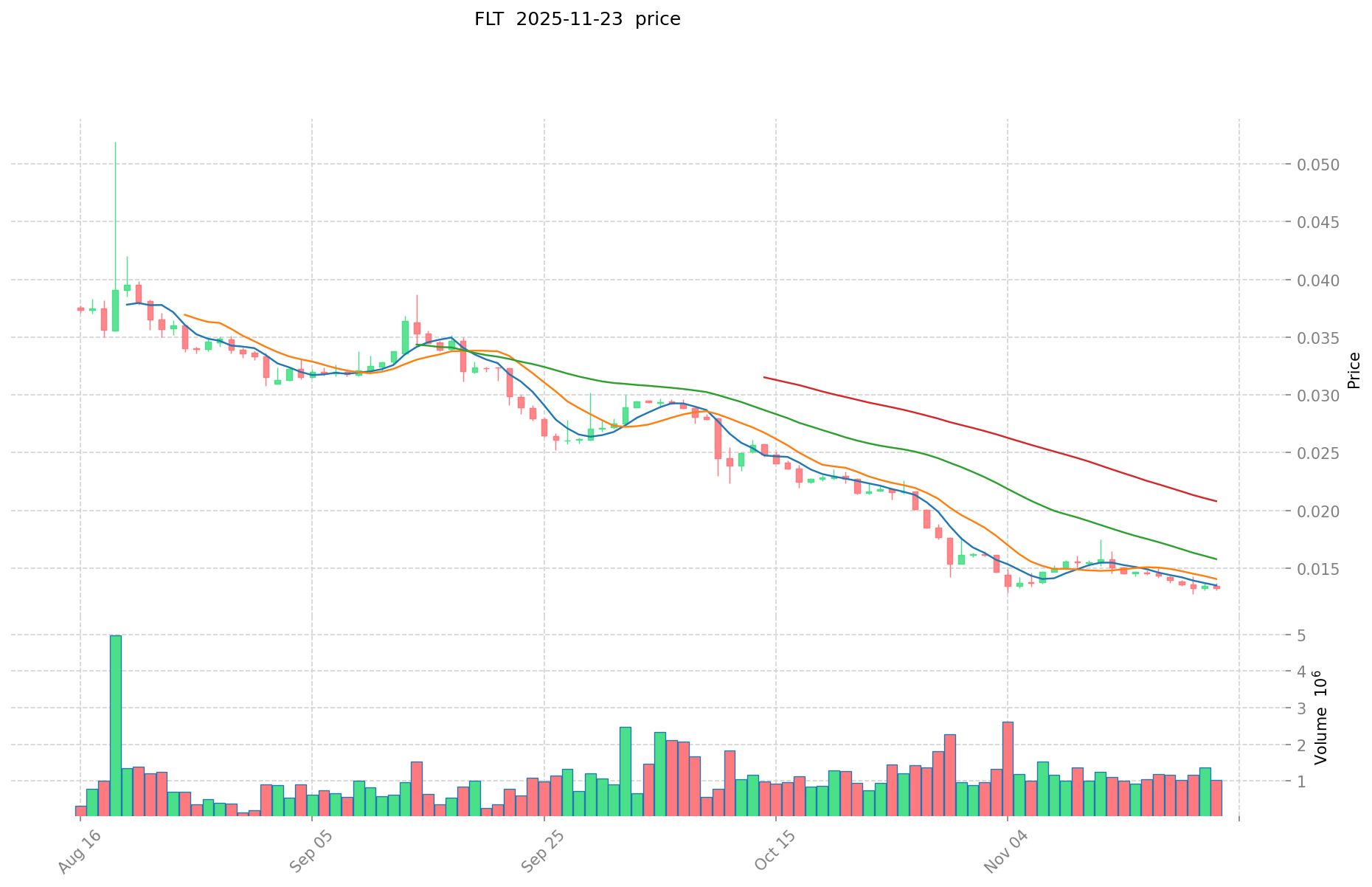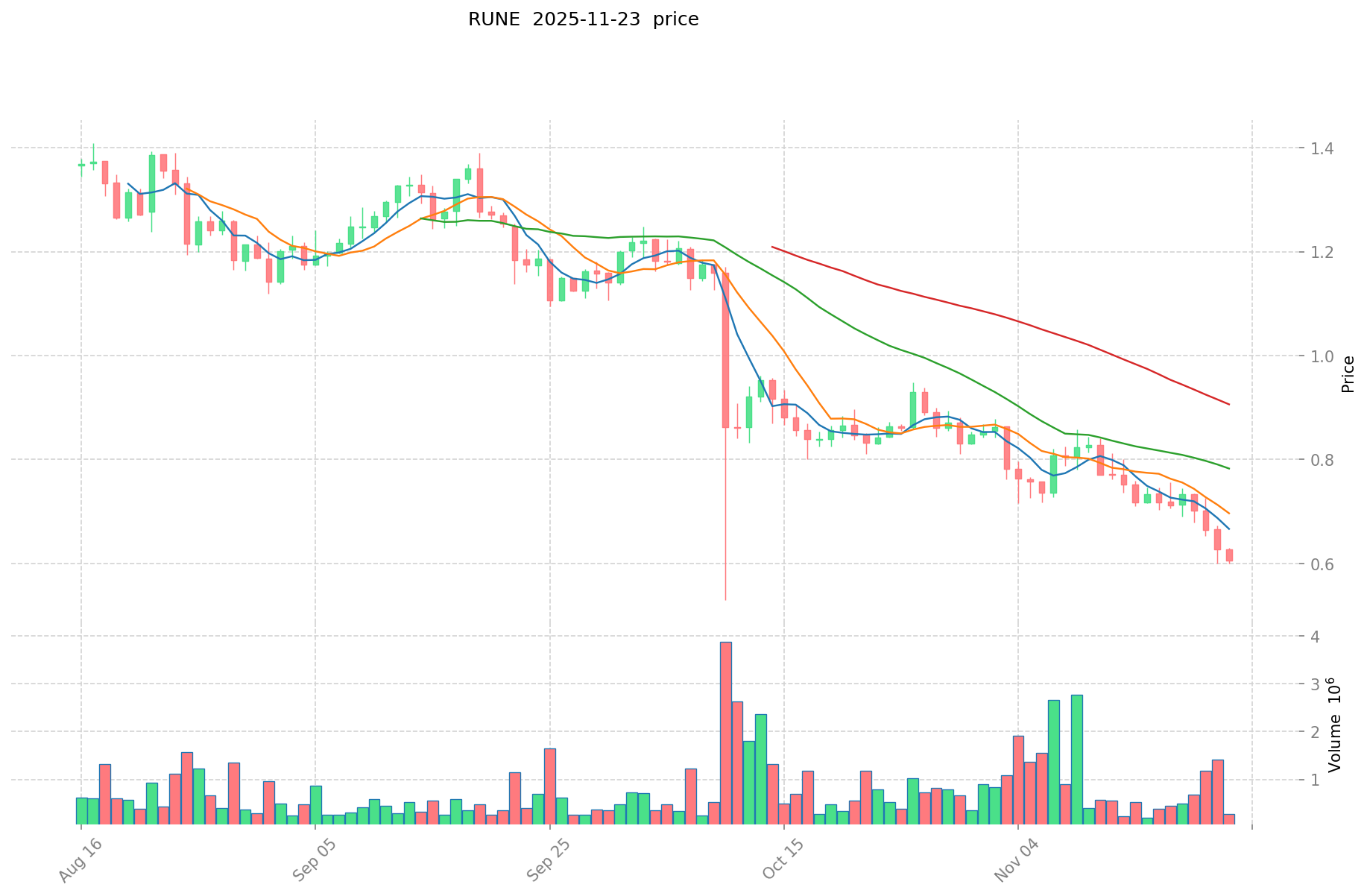FLT vs RUNE: Comparing Two Cryptocurrencies in the DeFi Ecosystem
Introduction: FLT vs RUNE Investment Comparison
In the cryptocurrency market, the comparison between Fluence (FLT) vs RUNE (RUNE) has been an unavoidable topic for investors. The two not only show significant differences in market cap ranking, application scenarios, and price performance, but also represent different positioning in the crypto asset landscape.
Fluence (FLT): Since its launch, it has gained market recognition for its position as the first decentralized "Cloudless" computing platform.
RUNE (RUNE): Since its inception in 2019, it has been hailed as a highly optimized multi-chain solution, being one of the cryptocurrencies with high global trading volume and market capitalization.
This article will comprehensively analyze the investment value comparison between FLT and RUNE, focusing on historical price trends, supply mechanisms, institutional adoption, technological ecosystems, and future predictions, attempting to answer the question that investors care about most:
"Which is the better buy right now?"
I. Price History Comparison and Current Market Status
FLT (Coin A) and RUNE (Coin B) Historical Price Trends
- 2024: FLT reached its all-time high of $1.55 on March 25, 2024.
- 2021: RUNE hit its all-time high of $20.87 on May 19, 2021.
- Comparative analysis: Since their respective peaks, FLT has dropped to $0.01351, while RUNE has fallen to $0.625.
Current Market Situation (2025-11-24)
- FLT current price: $0.01351
- RUNE current price: $0.625
- 24-hour trading volume: FLT $20,284.61 vs RUNE $222,690.73
- Market Sentiment Index (Fear & Greed Index): 13 (Extreme Fear)
Click to view real-time prices:
- View FLT current price Market Price
- View RUNE current price Market Price


II. Key Factors Affecting Investment Value of FLT vs RUNE
Supply Mechanisms Comparison (Tokenomics)
- FLT: Fixed supply model with maximum 100 million tokens. Non-inflationary by design, with tokens unlocked over 3 years. Approximately 20% (20 million) allocated to the team, subject to a vesting period.
- RUNE: Deflationary model with maximum supply of 500 million tokens. Uses continuous liquidity pools where RUNE acts as settlement asset, with 1/3 of protocol revenue going to node operators.
- 📌 Historical pattern: Fixed supply assets like FLT tend to be more sensitive to demand shifts, while RUNE's liquidity pool model creates natural market-driven price discovery mechanisms.
Institutional Adoption and Market Applications
- Institutional holdings: RUNE has attracted more established crypto investment funds due to its longer track record and proven liquidity provision model.
- Enterprise adoption: RUNE has more developed cross-chain applications in DeFi, while FLT is positioned for mass adoption in consumer payments and settlements.
- Regulatory stance: Both face similar regulatory scrutiny as crypto assets, with neither having significant regulatory advantages over the other.
Technical Development and Ecosystem Building
- FLT technical development: Focused on payment functionality and compatibility with Web3 wallets, emphasizing consumer-friendly applications.
- RUNE technical development: Focused on cross-chain infrastructure with THORChain protocol enabling direct swaps between native assets without wrapped tokens.
- Ecosystem comparison: RUNE has a more established DeFi ecosystem with proven liquidity pools and yield opportunities, while FLT is building toward everyday payment use cases.
Macroeconomic Factors and Market Cycles
- Performance in inflationary environments: Both position themselves as alternative stores of value during inflation, with RUNE having more historical data to evaluate this claim.
- Macroeconomic monetary policies: Both are affected by risk-on/risk-off sentiment shifts driven by interest rate changes and dollar strength.
- Geopolitical factors: Cross-border transaction demand potentially benefits both tokens, with RUNE's cross-chain capabilities providing advantages during regional restrictions.
III. 2025-2030 Price Prediction: FLT vs RUNE
Short-term Prediction (2025)
- FLT: Conservative $0.0095921 - $0.01351 | Optimistic $0.01351 - $0.0191842
- RUNE: Conservative $0.56875 - $0.625 | Optimistic $0.625 - $0.7375
Mid-term Prediction (2027)
- FLT may enter a growth phase, with prices estimated between $0.014763883365 and $0.024971012605
- RUNE may enter a consolidation phase, with prices estimated between $0.4117134375 and $0.8960821875
- Key drivers: Institutional capital inflow, ETF, ecosystem development
Long-term Prediction (2030)
- FLT: Base scenario $0.019448535667348 - $0.031882845356309 | Optimistic scenario $0.031882845356309 - $0.041447698963201
- RUNE: Base scenario $0.604537523796679 - $1.099159134175781 | Optimistic scenario $1.099159134175781 - $1.35196573503621
Disclaimer: This information is for educational purposes only and should not be considered as financial advice. Cryptocurrency markets are highly volatile and unpredictable. Always conduct your own research before making any investment decisions.
FLT:
| 年份 | 预测最高价 | 预测平均价格 | 预测最低价 | 涨跌幅 |
|---|---|---|---|---|
| 2025 | 0.0191842 | 0.01351 | 0.0095921 | 0 |
| 2026 | 0.020106933 | 0.0163471 | 0.013568093 | 21 |
| 2027 | 0.024971012605 | 0.0182270165 | 0.014763883365 | 34 |
| 2028 | 0.030454610519025 | 0.0215990145525 | 0.011015497421775 | 59 |
| 2029 | 0.037738878176855 | 0.026026812535762 | 0.022383058780755 | 92 |
| 2030 | 0.041447698963201 | 0.031882845356309 | 0.019448535667348 | 135 |
RUNE:
| 年份 | 预测最高价 | 预测平均价格 | 预测最低价 | 涨跌幅 |
|---|---|---|---|---|
| 2025 | 0.7375 | 0.625 | 0.56875 | 0 |
| 2026 | 0.9333125 | 0.68125 | 0.395125 | 9 |
| 2027 | 0.8960821875 | 0.80728125 | 0.4117134375 | 29 |
| 2028 | 0.9283330734375 | 0.85168171875 | 0.732446278125 | 36 |
| 2029 | 1.308310872257812 | 0.89000739609375 | 0.827706878367187 | 42 |
| 2030 | 1.35196573503621 | 1.099159134175781 | 0.604537523796679 | 76 |
IV. Investment Strategy Comparison: FLT vs RUNE
Long-term vs Short-term Investment Strategy
- FLT: Suitable for investors focusing on payment scenarios and ecosystem potential
- RUNE: Suitable for investors seeking stability and cross-chain infrastructure exposure
Risk Management and Asset Allocation
- Conservative investors: FLT: 30% vs RUNE: 70%
- Aggressive investors: FLT: 60% vs RUNE: 40%
- Hedging tools: Stablecoin allocation, options, cross-currency portfolio
V. Potential Risk Comparison
Market Risk
- FLT: Higher volatility due to smaller market cap and lower liquidity
- RUNE: Exposure to broader DeFi market fluctuations
Technical Risk
- FLT: Scalability, network stability
- RUNE: Centralization of liquidity pools, smart contract vulnerabilities
Regulatory Risk
- Global regulatory policies may impact both tokens differently, with RUNE potentially facing more scrutiny due to its DeFi focus
VI. Conclusion: Which Is the Better Buy?
📌 Investment Value Summary:
- FLT advantages: Potential for growth in consumer payment applications, fixed supply model
- RUNE advantages: Established cross-chain infrastructure, proven liquidity provision model
✅ Investment Advice:
- New investors: Consider a balanced approach with a slight preference for RUNE due to its more established ecosystem
- Experienced investors: Evaluate both based on risk tolerance and belief in respective use cases
- Institutional investors: RUNE may offer more immediate opportunities in DeFi, while FLT presents a longer-term play on consumer adoption
⚠️ Risk Warning: Cryptocurrency markets are highly volatile. This article does not constitute investment advice. None
VII. FAQ
Q1: What are the main differences between FLT and RUNE? A: FLT is a fixed supply token focused on decentralized computing and payment functionality, while RUNE is a deflationary token designed for cross-chain liquidity provision in DeFi. FLT has a maximum supply of 100 million tokens, whereas RUNE has a maximum of 500 million tokens.
Q2: Which token has performed better historically? A: RUNE has historically shown better performance, reaching an all-time high of $20.87 in May 2021. FLT's all-time high was $1.55 in March 2024. However, both have experienced significant price drops since their peaks.
Q3: How do the supply mechanisms of FLT and RUNE differ? A: FLT uses a fixed supply model with a maximum of 100 million tokens, unlocked over 3 years. RUNE employs a deflationary model with continuous liquidity pools, where 1/3 of protocol revenue goes to node operators.
Q4: Which token has better institutional adoption? A: RUNE has attracted more established crypto investment funds due to its longer track record and proven liquidity provision model in DeFi applications.
Q5: What are the key technical focuses of each token? A: FLT focuses on payment functionality and compatibility with Web3 wallets for consumer-friendly applications. RUNE concentrates on cross-chain infrastructure, enabling direct swaps between native assets without wrapped tokens.
Q6: How do the long-term price predictions for FLT and RUNE compare? A: For 2030, FLT's base scenario predicts $0.019448535667348 - $0.031882845356309, while RUNE's base scenario predicts $0.604537523796679 - $1.099159134175781. RUNE is expected to have a higher price range in the long term.
Q7: What are the main risks associated with investing in FLT and RUNE? A: FLT faces higher volatility due to its smaller market cap and lower liquidity. RUNE is exposed to broader DeFi market fluctuations. Both face technical risks such as scalability and network stability, as well as potential regulatory challenges.
Q8: Which token might be more suitable for different types of investors? A: New investors might consider a balanced approach with a slight preference for RUNE due to its more established ecosystem. Experienced investors should evaluate both based on their risk tolerance and belief in respective use cases. Institutional investors may find more immediate opportunities in RUNE for DeFi exposure, while FLT presents a longer-term opportunity in consumer adoption.
Share
Content